The Way God Works in the Universe
Keywords:
Necessity, Chance, Anthropic Principle, Ontological LeapAbstract
Around 14.5 billion years ago, at the Big Bang, our universe originated. Amidst the myriads of planets in the cosmos, given our current knowledge, only planet earth is capable of harboring intelligent life forms. Life originated out of a primordial soup of essential elements. This event was named as an ontological leap, meaning that life’s essential basic super-complex molecule, the DNA could not have evolved by natural selection and that a Super Intellect should have designed it. The evolution of life into humans (Homosapiens) makes many evolutionary biologists accept the notion that an anthropic principle was built into the fabric of biological evolution. The God of religion is both faithful and loving and the natural gift of the faithful God will be reliability in the operation of creation. The natural gift of a loving God will be independence granted to creation. This is reflected in the fruitful interplay of chance and necessity, flexibility and rigidity in evolving cosmic history.
References
Barbour, I. (2000). When science meets religion. New York: Harper Collins.
Chardin, de T. (1955).The Phenomenon of Man (Le Phenomene Humaine). UK: William Collins.
Chardin, de T. (2004). The Divine Milieu. Sussex: Academic Press.
Crick, F. (1995). Astonishing hypothesis: The scientific search for the Soul. New York. Touchstone.
Darwin, C. (1859). The origin of species. London: John Murray.
Davies, P. (1983). God and new physics. UK: Dent.
Dawkins, R. (1986). The blind watchmaker. UK: Penguin Books.
Dirac, P. (1958). The principles of quantum mechanics. Oxford: Clarenton Press.
Dobzansky, T. (1937). Genetics and the origin of species. Washington: National Academy of Sciences.
Einstein, A. (2008). The collected papers of Albert Einstein. USA: The Princeton University Press.
Hawking, S. (1988). A brief history of time. New York. Bantam Books.
Hitchins, C. (2017). In L. Taunton, (Ed.), The faith of Christopher Hitchins: The restless soul of the world’s most notorious atheist. USA: Nelson Books.
Hoyle, F. (2005). In J. Gregory, (Ed.), Fred Hoyle’s universe. UK: Oxford University Press.
Hubble, E. (2013). The realm of the Nebulae. USA: Yale University Press.
Lameitre, G. (1931). The beginning of the world from the point of view of quantum theory. Nature, 127, 706.
Lovelock, J. (2016). Gaia: A new look at life on Earth. Oxford: Oxford University Press.
Newton, I. (1687). Philasophiae Naturalis Principia Mathematica. London: Peppy Press.
Peacoke, A. (2001). Paths from science towards God. London: Oneworld.
Polkinghorne, J. (1996). Science and Christian belief. UK. Fortress.
Polkinghorne, J. (1998). Belief in God in an age of science. USA: Yale University Press.
Polkinghorne, J. (2002). The God of hope and the end of the world. USA: Yale University Press.
Polkinghorne, J. (2005). Quarks, chaos and Christianity. UK: APCK.
Watson, J. (1968). The double helix: A personal account of the discovery of the structure of DNA. USA: Simon & Schuster.


